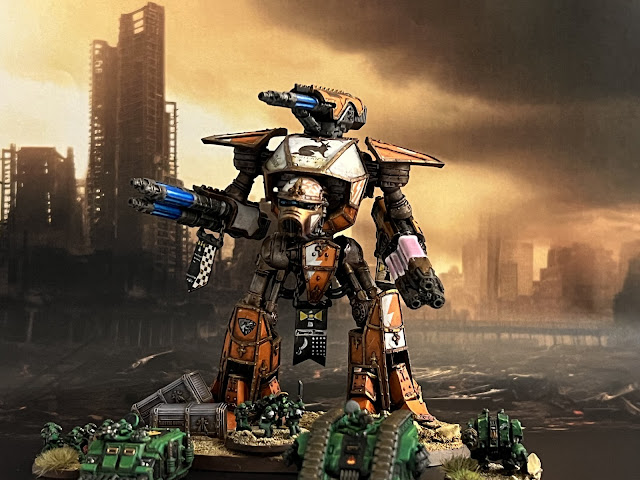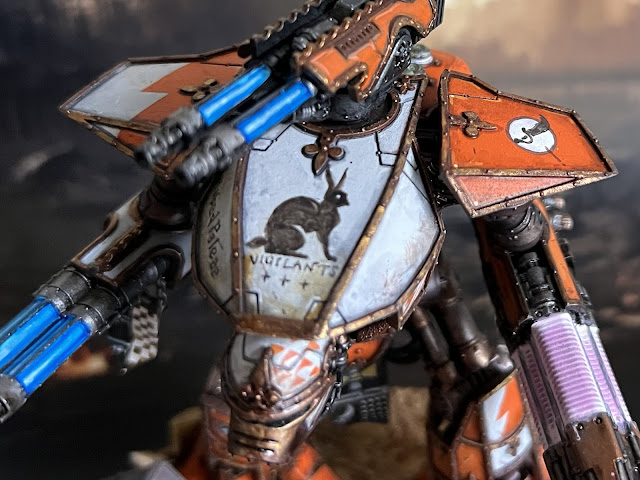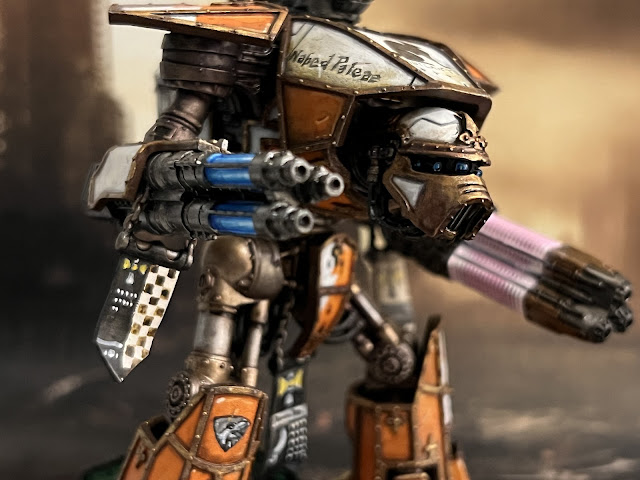+ Tinctures and markings – adding detail to your Titans +
 |
| + Profugon Iratus looms protectively over a supporting Salamanders detachment during the . + |
+ The scheme and method I used for this Reaver are detailed in an earlier inload [+noosphericinloadlink embedded+], but I hadn't had a chance to post up the Titan with the details and markings in place – so I thought I'd gather some thoughts on how to detail your Titans. +
+++
+ Theoretical: Why personalise your Titan? +
+ Titans have a will and personality of their own. The character and identity of each War Engine is unique, and is informed and shaped by the actions in which it walks; the Princeps that direct it; and the Legio to which it belongs. +
+ One of the Mysteries of the Adeptus Mechanicus states: 'The Soulless Sentience is the Enemy of All' – a half-understood lesson passed down by rote since the Age of Strife, when Abominable Intelligence nearly wiped out humanity. It is because they are invested with a sentience of their own that Titans are unlike mechs and similar giant robots in most other sci-fi properties. No mere vehicles, the War Engines of the Collegia Titanicus are beings with a drive and character of their own. It's good to reflect that in your models. +
 |
| What's a Titan without a history and a name? Just a bit mound of metal. |
+ Titans are individuals, and deserve some extra time and effort to reflect their nature. This is a key part of to their appeal to the painter and modeller. Quite aside from anything else, you'll only have half a dozen or so in your whole force, so you really can go to town and make a character out of each of them. +
+ Nameplates +
+ A nameplate helps to establish your Titan's legend. It provides insight into your Titan's background and makes it less anonymous to viewers. There are a few different places you can buy them, but I've always been slightly apprehensive about spending money on one only to find it doesn't quite look how I wanted. +
+ Alex and Johnny at Maximal Fire put me onto BattleBuilder, (battlebuilder.net) which launches today. The neat things about this option is that it lets you get things just as you picture them – it's got a live visualiser, so you can play about with fonts and styles, change the size of the base and look at it from different angles 'til you find the one that's right for you. +
+ I'll be posting more about it in its own article – but suffice to say that I'm looking forward to adding a plate to Profugon Iratus – just as soon as I can make a final decision on style! +
+++
+ Practical: How to personalise your Titan +
+ The Titan Legion you've chosen will inform how you plan things. Nearly all Titan Legions have bold heraldic scheme. (If you'd like some general guidance, I've written about planning heraldic colour schemes before in this inload). Your details need to stand out, without covering things completely or muddling the overall impression. +
+ How much to paint? +
+ To ensure things don't get too fussy, I recommend that you leave between three-quarters and two-thirds of the base scheme showing – that is, leave a number of plates in the main colours of your Legio. If you've used parts with sculpted detail (like the kneepad of the yellow Legio Validus engine below), then count these amongst the detailed ones. +
 |
| + Legio Validus engine on the left, Legio Maximal on the right + |
+ Where to add the markings? +
+ Once you've decided how many plates to personalise, the next step is to decide which plates you want to add the markings to. Find a balance between in-universe narrative and on-table impact. These markings are there to boast of the Titan's prowess and individual history, so primarily need to be visible to the enemy – and as Titan Legions tend to regard their only equals to be other Engines, your Titan's most prominent markings should be at eye level to other Titans. +
+ There are, of course, exceptions. Your Legio may want to inspire their supporting infantry, for example, and so favour markings visible on the chestplate and lower legs – see above for what a Titan looks like to supporting forces. Generally, however, I'd suggest that you have the boldest markings on and around the carapace, as these are most visible to you and the other player during games, and to viewers when they are on display. +
 |
| + Rear view – no markings; just the Legion's colours for easy identificaton by allies. + |
 |
| + Front view – the Titan's history and reputation laid bare for all to witness. + |
+++
+ What medium to use? +
+ Two main avenues are open to you:(decals) and freehand painting. You can use a combination of these, but try to ensure visual harmony. It'll look odd to have super finely-detailed transfers with relatively blocky freehand, so unless you are very confident with your draughtsmanship, I'd suggest combining freehand only with bold geometric transfers, rather than the very fine ones available from GW and third party suppliers. +
+ I can thoroughly recommend transfers – both the official ones and third-party transfers are available, and the fine detail really helps sell the scale. They're also quick to apply and, being mass-produced, will provide great uniformity across a Maniple. +
+ If, however, you are hesitant about freehand, I'd thoroughly encourage you to give it a go. It doesn't have to be intricate or complex – straight lines are a great place to start, and if you're afraid even of these, then consider using low-tack masking tape to help guide you. +
+ The other advantage of freehand, of course, is that your imagination is the limit. This approach is ideal for creating a Titan Legion of your own. +
+++
+ Let's give it a go – bringing Profugon Iratus of the Legio Maximal to life +
+ This Titan belongs to the Legio Maximal. Here's the video on the Maximal Fire Youtube channel:
+ As noted here, the lore didn't include any mention of the colours, so after a bit of consultation with Maximal Fire's Alex (@peakethepainter) and with some excellent ideas and advice on @no_games_no_glory I adopted the orange and white of the website as the main heraldry. +
+ Black is used for the banners – and if you wanted to paint up a Traitor Engine from the Legio Maximal, you might try orange and black as the main tinctures, with white banners. +
+ As a base scheme, I used Grey Seer highlighted up to white, and Trollslayer Orange – but this is far from definitive. @no_games_no_glory suggested the following, which also looks great:
Primed- Colourforge BoneBasecoat- Vallejo Rotten White fading into Vallejo Ghost GreyThe flames were-GW- Mephison Red, fading into Vallejo Lava Orange and then into Two Thin Coats Yellow Flame.TrimBase- Scale 75 Black MetalHighlight- Scale 75 Thrash Metal
+++
+ Now for the markings +
+ With the base scheme in place, we turn to decide on the markings. These can be split into two categories: patterns and icons. The former are things like chequerboards, dags, and so forth; the latter simplified shapes – everything from eyes to tridents to flaming swords. Both can inform the themes you choose to bring in. +
+ Most Legios have established common patterns – star charts, chequers, hexes, webbing etc. Where you don't have these provided, turn to the lore for inspiration. +
+ The Legio Maximal's Low Gothic name is 'the Vigilants', referencing their widely-spread nature and responsiveness across a large area. Speed and watchfulness are thus key themes. +
 |
| The half-chequers on the right-hand side of the head are done simply by drawing small tessallating right-angled triangles. |
+ Patterning: Speed can be reflected through the use of zig-zags – which also nicely nod to Maximal Fire's new logo. Stripes would also fit in nicely. +
+ Icons: Traditional heraldry will often help you find something a bit more exciting than tired old Eyes and Eagles, so use reference where you can. This noospheric node [+noosphericexlaodlink embedded+] is a good place to start, for example. Browse or search for the quality you want to reflect. +
+++
+ Patterns +
+ The shoulder pad on the left-hand side of this picture shows a zig-zag break made with simple straight lines. +
+ The same principle is used on the kneepad here. For variation, you might swap the colours or direction of the pattern. Note also the repeated striping on the side of the carapace, where the zig-zagging is double. You might extend the pattern across the whole of a larger plate. +
+ Don't look on the trim as a restriction. Broken patterns – that is, where the overall shapes crosses a bit of trim – are possible, and help to ensure the Titan doesn't look too 'bitty'. The groin plate is a good example of this practise. +
+++
+ Freehand +
+ Returning to the carapace, you'll see a large freehand hare in the centre of the carapace. Having a single strong icon as a focal point can be striking. You'll also note a geometric shape (circle) with simple cutlass icon on the right-hand side. +
+ Why a hare? Not the most obviously vicious animal, but all the more notable for that. Hares have a traditional heraldic meanings of intelligence in warfare, and are also familiar for their speed and watchfulness – thus well-suited to the Legio's background. You could do something more +
+ The cutlass, meanwhile, is a visual nod to the Corsair Cluster – the Legio Maximal's domain and area of responsibility. +
+++
+ Freehand text also falls under this category. You might choose to record a particular campaign, the name of a notable (or current) Princeps, or, as in this example, the name of the Legio's Forgethrone, Nabed-Paleae. +
+ Try different fonts for this – black letter or other serif fonts can be fun to try. +
+++
+ Banners +
+ There's an article on making your own banners on its way, but they are another fun opportunity for you to add some flavour. These – I confess – were rather rushed, but the principles at play are worth highlighting. +

+ Here you can see the basic idea: a simple larger icon at the top, over a smaller split area that contains patterns or small icons. +
+ The banner between the legs represents the Titan itself, and contains the Titan's name – rendered abstractly, with dots and lines – below a lighthouse icon. Below the name band is the cutlass icon again – this time in white on black; and a series of dots on the right. This might indicate kill-count, or perhaps campaigns in which it's served. +
+ Weapons sometimes have Moderati banners, detailing the feats of the individual master of the weapon. These are smaller, and generally suit a simpler approach. +
+++
+ Personality and finishing touches +
+ It is intimidating to paint the first Titan of a new Maniple (or Legio!), but as you can see here, the process is easily broken down into manageable chunks. ++ If you're struggling for inspiration on things like icons, the Titan's name can provide a starting point. It's also an opportunity to add a final finishing touch to your model – after which your Titan can start building its legend! +
+ This last point is why nameplates are a good idea for gaming. They remind you that you're aiming to tell a story with another player – so having the names right in front of you is a friendly way to help you both do so. Consider which is more immersive – 'Profugon Iratus targets the Dread Hellespontion with its turbo-laser' or 'My Reaver shoots its turbo-laser at your Warbringer'? +












This work is so awesome at so many different levels that I don't even know where to start. Fantastic job all over!
ReplyDelete